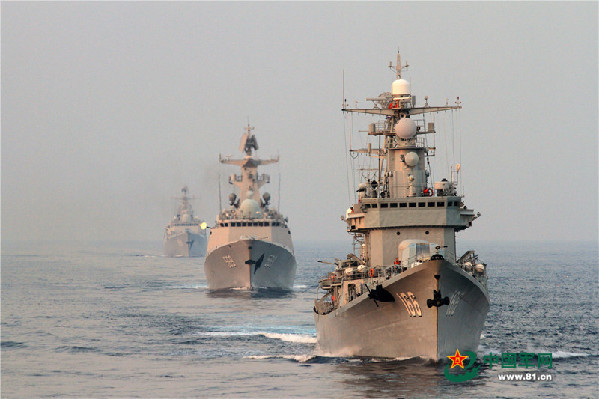Hidden China-US struggles under South China Sea lighthouse
- By Zhang Jingwei
 0 Comment(s)
0 Comment(s) Print
Print E-mail China.org.cn, October 30, 2015
E-mail China.org.cn, October 30, 2015
|
|
|
Guided-missile destroyers sail in a sea area of the South China Sea during a confrontation drill. Recently, a guided-missile destroyer flotilla under the South China Sea Fleet of the PLA Navy organized its warships to conduct a realistic confrontation training exercise, including such subjects as formation offense and defense, visit, board, search and seizure, anti-shore firing at night and anti-aircraft firing in complex electromagnetic environment. (Source: 81.cn) |
Years ago, before contentions in the South China Sea became this fierce, China and the United States had ship standoffs in the waters and aerial encounters that resulted in the crash of a Chinese fighter jet and the forced landing of a U.S. reconnaissance jet in China. These crises were all later properly solved.
In the current South China Sea struggles, the United States wants to play it up and seems ready to do anything for Southeast Asian countries. At the same time, it still wishes to act like an impartial arbitrator.
In such a self-contradiction, Washington thinks it is necessary to send naval ships to patrol within the 12-nautical miles, ignoring the cost that such high-profile acts might incur upon itself.
In simple words, Chinese lighthouses and U.S. ship patrols are an episode of the current China-U.S. contentions in the South China Sea.
But in the meantime, the two countries have never stopped their bilateral military exchange. On Oct. 13, PLA navy training ship the "Zheng He" cruised into Pearl Harbor and six days later, a delegation of U.S. naval captains boarded Chinese aircraft carrier the "Liaoning."
The PLA navy commander Wu Shengli has said that the naval ties between China and the United States are entering the best period in history, and that exchange between frontline naval troops will gradually become institutionalized. Similarly, the U.S. Pacific Command's former deputy commander Douglas M. Fraser said the two militaries' exchange should be continued.
The hidden China-U.S. struggles could be interpreted as Washington's bluffing in that it has to assume this tough stance to assure southeastern Asian countries, an aim the United States has achieved.
The sovereignty disputes between China and Southeast Asian countries over the South China Sea will not disappear but even intensify, as understandably, not a single party in the region dares to back down on sovereignty issues.
For countries outside the region, Japan will get itself involved from time to time while the United States wants to play both the leader and the referee, accusing China all the time, although the country's interferences were only in the name of navigational freedom.
Neither land reclamation nor new lighthouses will impose a threat to navigation in the South China Sea, but they are the main reason for the constant however manageable China-U.S. struggles.
The author is a research fellow at the Charhar Institute.
The article was translated by Chen Boyuan. Its original and unabridged version was published in Chinese.
Opinion articles reflect the views of their authors only, and not necessarily those of China.org.cn.




Go to Forum >>0 Comment(s)